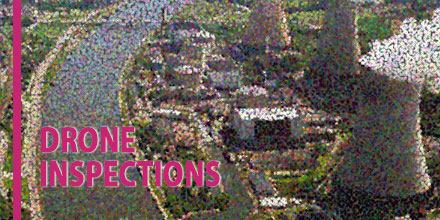 High-precision GPS receivers mounted on drones able to identify 1mm hairline defects in cooling towers
High-precision GPS receivers mounted on drones able to identify 1mm hairline defects in cooling towers
Drones rise to the challenge
How do you inspect a structure that’s almost 160 m high and 120 m in diameter? With a few weeks to spare, a crash course in abseiling and a head for heights, a person could certainly give it a go.
Imagine, however, that you need to collect enough data for a 3D model with the precision of 1 mm…all within a week.
This was the challenge facing Aetos Drones. The company was tasked with inspecting a cooling tower at Tihange Nuclear Power Station near Liege in Belgium.
Keeping reactors in top condition
The three reactors at the Tihange Power Station came online between 1975 and 1985. This makes the oldest of the three over 40 years old. Cooling towers built in this era have a life expectancy of 15-20 years. But, with careful maintenance, the lifetime can extend a further 20 years.
The Tihange reactors contribute about 25% of all electricity generated in Belgium. The plan is to decommission the towers in 2025. Until then, the cooling towers need to be kept in good working order.
Fortunately, drones equipped with highly precise and reliable GPS receivers can help.
Corrosion and cooling towers
Pressurized Water Reactors, such as at Tihange, have cooling towers. These towers supply cold water to the condenser which works to cool the steam back into water. The steam drives the electricity-generating turbines.
Cooling towers are elegantly simple in their operation. Warm water from the condenser sprays into the tower through a network of sprinklers, warming the surrounding air and causing it to rise. This in turn draws cooler air in through openings in the base of the tower maintaining a constant, natural draft of cool air through the tower.
Corrosion is a possibility in any system where water plays a part.
Cooling towers are hollow, thin-walled structures made from reinforced concrete. Over time, the humid environment can corrode the metal elements of the tower. In every cycle through the cooling tower, about 2% of the water evaporates forming the characteristic steam clouds. This increases the salt concentration in the remaining water which increases its corrosive power.
In addition, high winds and winter icing can also cause damage and weaken the cooling tower.
The inspection
Aetos Drones, were called in to carry out the inspections. And, Belgian's first certified drone pilot, Lieve Van Gijsel, took the helm.
An octocopter fitted with a high-resolution camera, a RADAR system and an AsteRx-m UAS receiver conducted the inspection. The air vehicle took photographs at regular intervals as it traveled vertically up and down the sides of the cooling tower.
The RADAR system was AIRobot’s Ranger, an add-on sensor specifically designed for distance detection on UAVs. The octocopter needed to get close enough to get quality images. However, the octocopter needed to maintain enough distance so as not to risk getting tossed around by the turbulence generated by the tower.
Processing the images
Over the course of 4 days, more than 19,000 photographs of the cooling tower were taken.
During the flight, the AsteRx-m UAS receiver logged GNSS measurements and the exact time each photograph was taken.
After the flight, these shutter times and GNSS measurements were combined with GNSS measurements from a nearby base station using Septentrio’s GeoTagZ software. As such, each photograph was stamped with the cm-level precise RTK position of the camera – the ideal input for the next processing stage.
After processing with GeoTagZ, the photographs were then uploaded to the photogrammetry software Agisoft PhotoScan. Over the course of several days, the photographs were stitched together to produce a highly-detailed 3D model of the cooling tower, precise to the level of 1 mm. Experts at Tihange then analyzed the surface of the cooling tower down to any required level of detail.
Precise yes, but also reliable
3D inspection models with 1 mm resolution are made possible using high-quality, multi-frequency GNSS measurements from high-end receivers like the AsteRx-m.
Not only does the positioning have to be precise, it has to be reliable. This requires: accurate error models, continuous tracking during mechanical jolts and advanced satellite integrity monitoring (RAIM).
For large-structure inspections, such as this, multi-constellation positioning is essential to ensure there are always enough satellites available to work with. The receiver will also need a good multipath mitigation filter (APME) to disentangle direct and reflected satellite signals to avoid jumps in the calculated position.
AsteRx-m2 UAS
The AsteRx-m UAS established itself as the receiver of choice for UAV applications requiring high-precision positioning. With the recent release of the
AsteRx-m2 UAS, drone inspections can take on applications at an entirely new level of difficulty.
The AsteRx-m2 UAS adds BeiDou and Galileo as well as L5 frequency tracking. It also includes the AIM+ interference mitigation system. The additional constellations allow operation in areas where overhead structures limit the scope of single and dual-constellation receivers.
Shop
Septentrio's line of high accuracy receivers at Unmanned Systems Source.
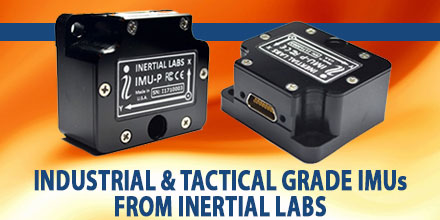 Inertial Labs, Inc. developer and supplier of high performance Inertial Sensors & Systems, recently released its Industrial and Tactical grade IMU-P, MEMS Inertial Measurement Units.
Since its introduction in 2015, the IMU-P received much acclaim as a MEMS Inertial Measurement Unit. The IMU-P's outstanding reliability and accuracy in challenging environments -- such as high vibration, rapidly changing temperature extremes, and tough mission profiles -- grew its success.
In addition to selling as a stand alone IMU, the IMU-P is integrated into Inertial Labs' AHRS, MRU, and GPS-Aided INS products.
Inertial Labs, Inc. developer and supplier of high performance Inertial Sensors & Systems, recently released its Industrial and Tactical grade IMU-P, MEMS Inertial Measurement Units.
Since its introduction in 2015, the IMU-P received much acclaim as a MEMS Inertial Measurement Unit. The IMU-P's outstanding reliability and accuracy in challenging environments -- such as high vibration, rapidly changing temperature extremes, and tough mission profiles -- grew its success.
In addition to selling as a stand alone IMU, the IMU-P is integrated into Inertial Labs' AHRS, MRU, and GPS-Aided INS products.

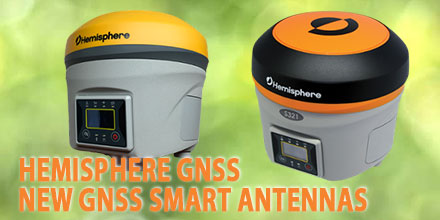 Hemisphere GNSS announced the release of their next-generation, multi-frequency, multi-GNSS S321+ and C321+ GNSS smart antennas. Hemisphere made the announcement at INTERGEO 2017, in Berlin, Germany.
Hemisphere GNSS announced the release of their next-generation, multi-frequency, multi-GNSS S321+ and C321+ GNSS smart antennas. Hemisphere made the announcement at INTERGEO 2017, in Berlin, Germany.
 High-precision GPS receivers mounted on drones able to identify 1mm hairline defects in cooling towers
High-precision GPS receivers mounted on drones able to identify 1mm hairline defects in cooling towers
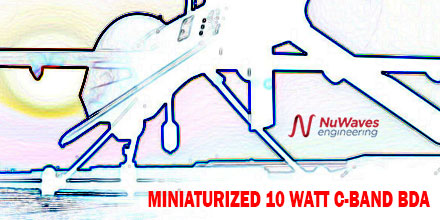 NuWaves Engineering announced the completion of the IRaD phase for their newest miniaturized 10 watt C-band bidirectional amplifier (BDA). This product adds to the existing line of NuPower Xtender bidirectional amplifiers.
Currently, plans are to price this at $2,900/ea in quantities of one hundred. It is available Q4 2017. NuWaves is an international Radio Frequency (RF) and Microwave solutions provider.
NuWaves continues to push their presence and expertise to higher-frequency applications. The NuPower Xtender C10RX01 and C10RX02 BDA modules follow the release of the 20 W C-Band Power Amplifier (C20R01) and the 20 W C-Band bidirectional amplifier (C20RX01).
This latest BDA offers the performance of a traditional power amplifier coupled with a low noise amplifier for receive mode. It provides an amplification solution in one miniaturized package for half-duplex transceivers.
NuWaves Engineering announced the completion of the IRaD phase for their newest miniaturized 10 watt C-band bidirectional amplifier (BDA). This product adds to the existing line of NuPower Xtender bidirectional amplifiers.
Currently, plans are to price this at $2,900/ea in quantities of one hundred. It is available Q4 2017. NuWaves is an international Radio Frequency (RF) and Microwave solutions provider.
NuWaves continues to push their presence and expertise to higher-frequency applications. The NuPower Xtender C10RX01 and C10RX02 BDA modules follow the release of the 20 W C-Band Power Amplifier (C20R01) and the 20 W C-Band bidirectional amplifier (C20RX01).
This latest BDA offers the performance of a traditional power amplifier coupled with a low noise amplifier for receive mode. It provides an amplification solution in one miniaturized package for half-duplex transceivers.
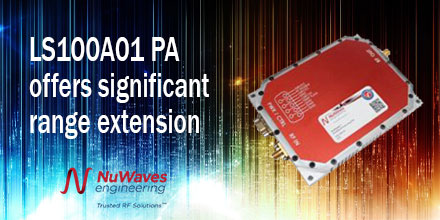 NuWaves Engineering recently announced the release of the 100 Watt NuPower LS100A01 L & S-band Power Amplifier (PA). It is the latest in the company’s small, lightweight and high-efficiency PA family of products.
With its size, weight, power, and cost (SWaP-C) profile, the NuPower LS100A01 provides significant range extension for communications systems, datalinks, and telemetry systems.
The PA also provides added power for electronic warfare systems such as airborne electronic attack (AEA) at low, medium, or high altitudes, and its low SWAP profile makes it ideal for medium-sized unmanned aircraft systems (UAS).
“For the systems integrator that requires greater communications range, the NuPower LS100A01 will provide a significant improvement with its 100 Watts of output power.” said Jeff Wells, President and CEO of NuWaves Engineering.
NuWaves Engineering recently announced the release of the 100 Watt NuPower LS100A01 L & S-band Power Amplifier (PA). It is the latest in the company’s small, lightweight and high-efficiency PA family of products.
With its size, weight, power, and cost (SWaP-C) profile, the NuPower LS100A01 provides significant range extension for communications systems, datalinks, and telemetry systems.
The PA also provides added power for electronic warfare systems such as airborne electronic attack (AEA) at low, medium, or high altitudes, and its low SWAP profile makes it ideal for medium-sized unmanned aircraft systems (UAS).
“For the systems integrator that requires greater communications range, the NuPower LS100A01 will provide a significant improvement with its 100 Watts of output power.” said Jeff Wells, President and CEO of NuWaves Engineering.
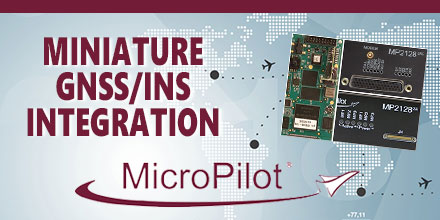 MicroPilot recently announced the completion of work to integrate an OxTS xNAV miniature GNSS/INS system in to their UAV autopilots.
The interface allows MicroPilot systems to use the blended GNSS/IMU output of the INS in their flight control system. This integration provides accurate positioning.
“We were excited to work together with MicroPilot to develop an interface between our systems," said Iain Clarke, Product Manager from OxTS. "As the UAV market continues to grow people are still discovering ways to take advantage of the platform. We hope this development brings new opportunities to customers looking for integrated systems and UAV navigation options.”
MicroPilot recently announced the completion of work to integrate an OxTS xNAV miniature GNSS/INS system in to their UAV autopilots.
The interface allows MicroPilot systems to use the blended GNSS/IMU output of the INS in their flight control system. This integration provides accurate positioning.
“We were excited to work together with MicroPilot to develop an interface between our systems," said Iain Clarke, Product Manager from OxTS. "As the UAV market continues to grow people are still discovering ways to take advantage of the platform. We hope this development brings new opportunities to customers looking for integrated systems and UAV navigation options.”
